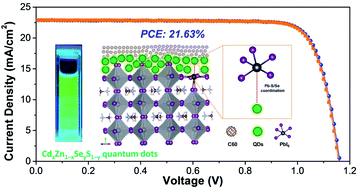Stabilizing n-type hetero-junctions for NiOx based inverted planar perovskite solar cells with an efficiency of 21.6%†
Abstract
The performance and stability of inverted perovskite solar cells (PSC), in particular, those with stable metal oxide hole transport layers, are limited by the instability of perovskite/electron transport layer heterojunctions. In this work, we demonstrate a successful strategy for passivating and stabilizing the perovskite/electronic transport layer n-type heterojunction in a nickel oxide based inverted planar PSC by using chemically stable inorganic CdxZn1−xSeyS1−y quantum dots (QDs). Experimental and theoretical results demonstrate that the defects/traps (unsaturated Pb2+ and mobile iodine ions) on perovskite surfaces can be substantially suppressed by the QDs, leading to a significant reduction of interfacial recombination and more stable n-type heterojunction. Consequently, a significant enhancement of the open-circuit voltage from 1.075 V to 1.162 V and power conversion efficiency from 19.47% to 21.63% is achieved for the QD passivated perovskite-based devices. We also demonstrate that the stabilized n-type hetero-junction results in a dramatic improvement of long-term and operational device stability. Our work demonstrates an effective and simple way to stabilize the perovskite/electron transport layer interface to develop high efficiency stable inverted planar PSCs, which will bring these devices closer to future commercial applications.



 Please wait while we load your content...
Please wait while we load your content...